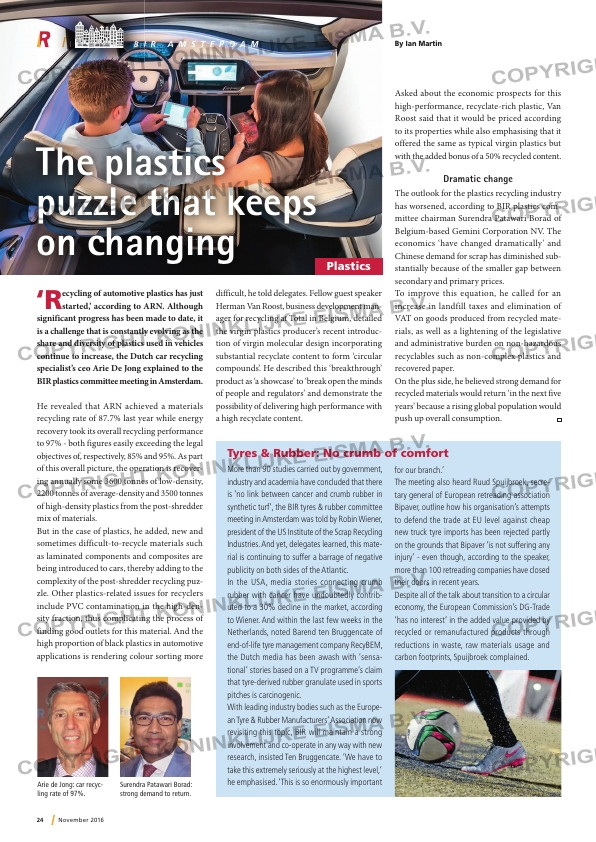Page 24 from: November 2016

24 November 2016
‘Recycling of automotive plastics has just started,’ according to ARN. Although
significant progress has been made to date, it
is a challenge that is constantly evolving as the
share and diversity of plastics used in vehicles
continue to increase, the Dutch car recycling
specialist’s ceo Arie De Jong explained to the
BIR plastics committee meeting in Amsterdam.
He revealed that ARN achieved a materials
recycling rate of 87.7% last year while energy
recovery took its overall recycling performance
to 97% – both figures easily exceeding the legal
objectives of, respectively, 85% and 95%. As part
of this overall picture, the operation is recover-
ing annually some 3600 tonnes of low-density,
2200 tonnes of average-density and 3500 tonnes
of high-density plastics from the post-shredder
mix of materials.
But in the case of plastics, he added, new and
sometimes difficult-to-recycle materials such
as laminated components and composites are
being introduced to cars, thereby adding to the
complexity of the post-shredder recycling puz-
zle. Other plastics-related issues for recyclers
include PVC contamination in the high-den-
sity fraction, thus complicating the process of
finding good outlets for this material. And the
high proportion of black plastics in automotive
applications is rendering colour sorting more
difficult, he told delegates. Fellow guest speaker
Herman Van Roost, business development man-
ager for recycling at Total in Belgium, detailed
the virgin plastics producer’s recent introduc-
tion of virgin molecular design incorporating
substantial recyclate content to form ‘circular
compounds’. He described this ‘breakthrough’
product as ‘a showcase’ to ‘break open the minds
of people and regulators’ and demonstrate the
possibility of delivering high performance with
a high recyclate content.
Asked about the economic prospects for this
high-performance, recyclate-rich plastic, Van
Roost said that it would be priced according
to its properties while also emphasising that it
offered the same as typical virgin plastics but
with the added bonus of a 50% recycled content.
Dramatic change
The outlook for the plastics recycling industry
has worsened, according to BIR plastics com-
mittee chairman Surendra Patawari Borad of
Belgium-based Gemini Corporation NV. The
economics ‘have changed dramatically’ and
Chinese demand for scrap has diminished sub-
stantially because of the smaller gap between
secondary and primary prices.
To improve this equation, he called for an
increase in landfill taxes and elimination of
VAT on goods produced from recycled mate-
rials, as well as a lightening of the legislative
and administrative burden on non-hazardous
recyclables such as non-complex plastics and
recovered paper.
On the plus side, he believed strong demand for
recycled materials would return ‘in the next five
years’ because a rising global population would
push up overall consumption.
Arie de Jong: car recyc-
ling rate of 97%.
Surendra Patawari Borad:
strong demand to return.
Tyres & Rubber: No crumb of comfort
More than 90 studies carried out by government,
industry and academia have concluded that there
is ‘no link between cancer and crumb rubber in
synthetic turf’, the BIR tyres & rubber committee
meeting in Amsterdam was told by Robin Wiener,
president of the US Institute of the Scrap Recycling
Industries. And yet, delegates learned, this mate-
rial is continuing to suffer a barrage of negative
publicity on both sides of the Atlantic.
In the USA, media stories connecting crumb
rubber with cancer have undoubtedly contrib-
uted to a 30% decline in the market, according
to Wiener. And within the last few weeks in the
Netherlands, noted Barend ten Bruggencate of
end-of-life tyre management company RecyBEM,
the Dutch media has been awash with ‘sensa-
tional’ stories based on a TV programme’s claim
that tyre-derived rubber granulate used in sports
pitches is carcinogenic.
With leading industry bodies such as the Europe-
an Tyre & Rubber Manufacturers’ Association now
revisiting this topic, BIR will maintain a strong
involvement and co-operate in any way with new
research, insisted Ten Bruggencate. ‘We have to
take this extremely seriously at the highest level,’
he emphasised. ‘This is so enormously important
for our branch.’
The meeting also heard Ruud Spuijbroek, secre-
tary general of European retreading association
Bipaver, outline how his organisation’s attempts
to defend the trade at EU level against cheap
new truck tyre imports has been rejected partly
on the grounds that Bipaver ‘is not suffering any
injury’ – even though, according to the speaker,
more than 100 retreading companies have closed
their doors in recent years.
Despite all of the talk about transition to a circular
economy, the European Commission’s DG-Trade
‘has no interest’ in the added value provided by
recycled or remanufactured products through
reductions in waste, raw materials usage and
carbon footprints, Spuijbroek complained.
The plastics
puzzle that keeps
on changing
B I R A M S T E R D A M By Ian Martin
Plastics



